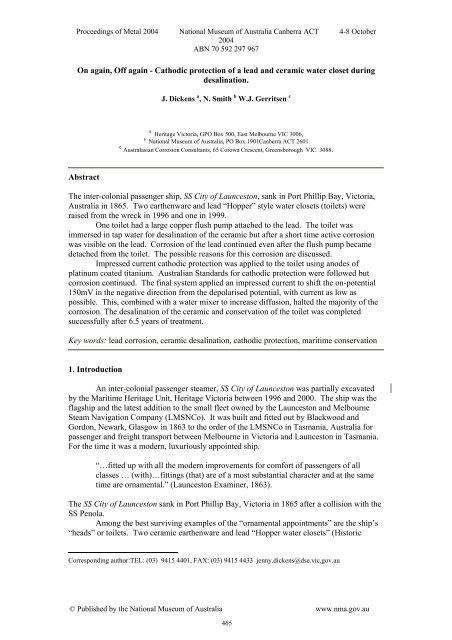Section 4: Composite artefacts (PDF 20858kb) - National Museum of ...
Section 4: Composite artefacts (PDF 20858kb) - National Museum of ...
Section 4: Composite artefacts (PDF 20858kb) - National Museum of ...
- No tags were found...
Create successful ePaper yourself
Turn your PDF publications into a flip-book with our unique Google optimized e-Paper software.
Proceedings <strong>of</strong> Metal 2004 <strong>National</strong> <strong>Museum</strong> <strong>of</strong> Australia Canberra ACT 4-8 October2004ABN 70 592 297 967On again, Off again - Cathodic protection <strong>of</strong> a lead and ceramic water closet duringdesalination.J. Dickens a , N. Smith b W.J. Gerritsen ca Heritage Victoria, GPO Box 500, East Melbourne VIC 3006,b <strong>National</strong> <strong>Museum</strong> <strong>of</strong> Australia, PO Box 1901Canberra ACT 2601cAustralasian Corrosion Consultants, 65 Corowa Crescent, Greensborough VIC 3088.AbstractThe inter-colonial passenger ship, SS City <strong>of</strong> Launceston, sank in Port Phillip Bay, Victoria,Australia in 1865. Two earthenware and lead “Hopper” style water closets (toilets) wereraised from the wreck in 1996 and one in 1999.One toilet had a large copper flush pump attached to the lead. The toilet wasimmersed in tap water for desalination <strong>of</strong> the ceramic but after a short time active corrosionwas visible on the lead. Corrosion <strong>of</strong> the lead continued even after the flush pump becamedetached from the toilet. The possible reasons for this corrosion are discussed.Impressed current cathodic protection was applied to the toilet using anodes <strong>of</strong>platinum coated titanium. Australian Standards for cathodic protection were followed butcorrosion continued. The final system applied an impressed current to shift the on-potential150mV in the negative direction from the depolarised potential, with current as low aspossible. This, combined with a water mixer to increase diffusion, halted the majority <strong>of</strong> thecorrosion. The desalination <strong>of</strong> the ceramic and conservation <strong>of</strong> the toilet was completedsuccessfully after 6.5 years <strong>of</strong> treatment.Key words: lead corrosion, ceramic desalination, cathodic protection, maritime conservation1. IntroductionAn inter-colonial passenger steamer, SS City <strong>of</strong> Launceston was partially excavatedby the Maritime Heritage Unit, Heritage Victoria between 1996 and 2000. The ship was theflagship and the latest addition to the small fleet owned by the Launceston and MelbourneSteam Navigation Company (LMSNCo). It was built and fitted out by Blackwood andGordon, Newark, Glasgow in 1863 to the order <strong>of</strong> the LMSNCo in Tasmania, Australia forpassenger and freight transport between Melbourne in Victoria and Launceston in Tasmania.For the time it was a modern, luxuriously appointed ship.“…fitted up with all the modern improvements for comfort <strong>of</strong> passengers <strong>of</strong> allclasses … (with)…fittings (that) are <strong>of</strong> a most substantial character and at the sametime are ornamental.” (Launceston Examiner, 1863).The SS City <strong>of</strong> Launceston sank in Port Phillip Bay, Victoria in 1865 after a collision with theSS Penola.Among the best surviving examples <strong>of</strong> the “ornamental appointments” are the ship’s“heads” or toilets. Two ceramic earthenware and lead “Hopper water closets” (HistoricCorresponding author:TEL: (03) 9415 4401, FAX: (03) 9415 4433 jenny.dickens@dse.vic.gov.au© Published by the <strong>National</strong> <strong>Museum</strong> <strong>of</strong> Australia www.nma.gov.au465
















